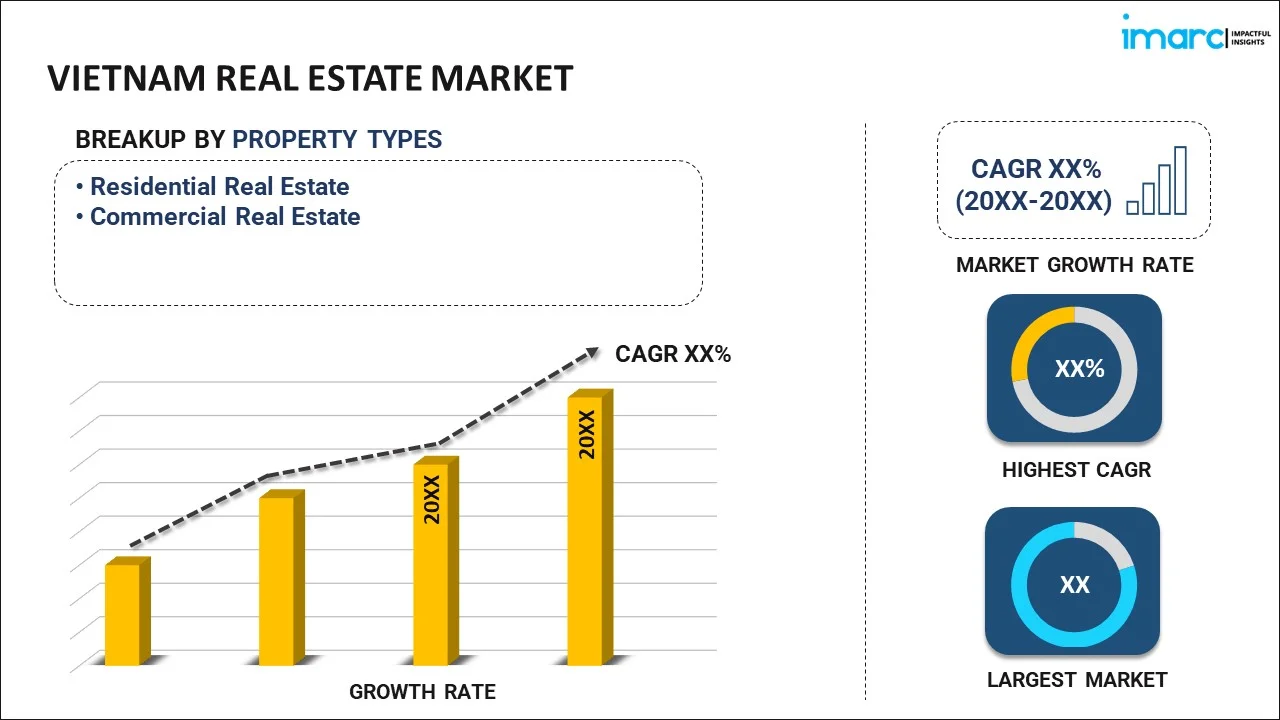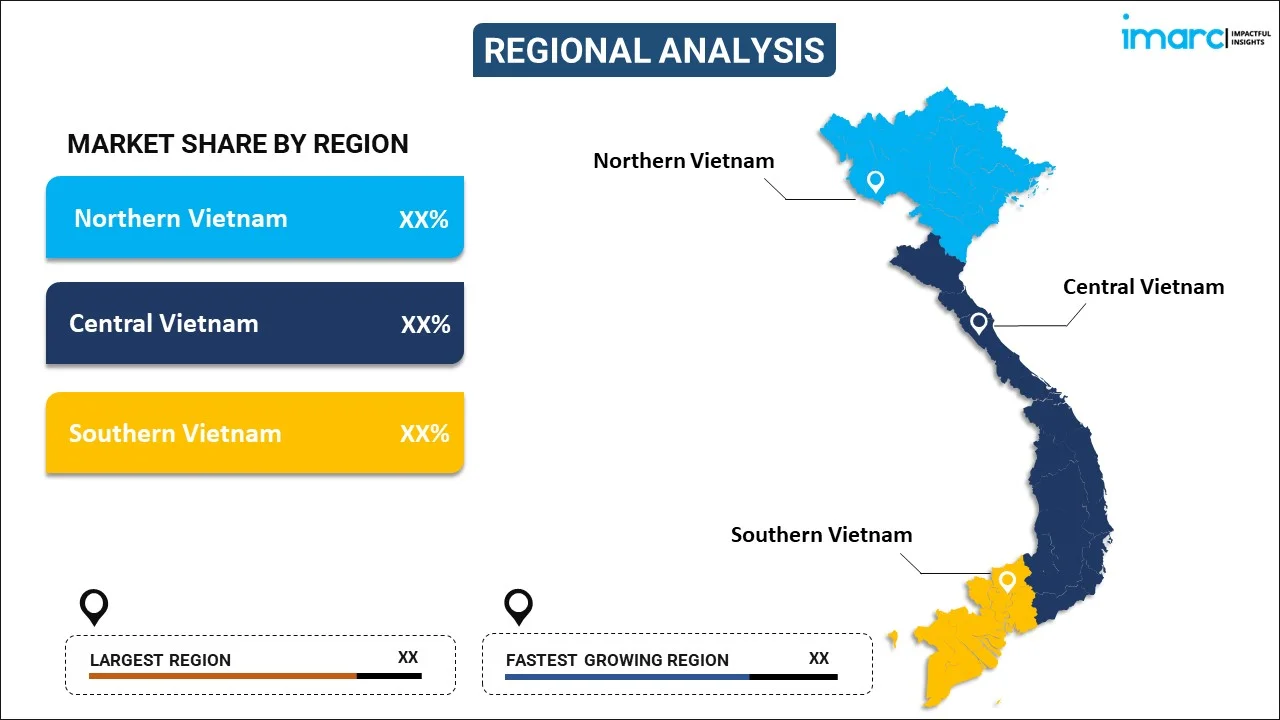
Vietnam Real Estate Market Report by Property Type (Residential Real Estate, Commercial Real Estate), and Region 2026-2034
Market Overview:
Vietnam real estate market size reached USD 30.0 Billion in 2025. Looking forward, IMARC Group expects the market to reach USD 34.8 Billion by 2034, exhibiting a growth rate (CAGR) of 1.64% during 2026-2034. Key drivers include rising urban migration, expanding residential projects, and supportive government policies. Notably, foreign direct investment (FDI) in Vietnam surged 46% year-on-year in Q1 2025, highlighting growing investor confidence. The market continues to attract attention as a prime investment hub in Southeast Asia, especially in commercial and industrial real estate segments.
|
Report Attribute
|
Key Statistics
|
|---|---|
|
Base Year
|
2025 |
|
Forecast Years
|
2026-2034
|
|
Historical Years
|
2020-2025
|
| Market Size in 2025 | USD 30.0 Billion |
| Market Forecast in 2034 | USD 34.8 Billion |
| Market Growth Rate (2026-2034) | 1.64% |
Access the full market insights report Request Sample
Real estate comprises properties, such as land, buildings, and infrastructure, and offers opportunities to individuals and companies for acquiring and owning property. It can generate rental income when properties are leased to tenants or provide a space for business operations. It can serve as a hedge against inflation, diversify an investment portfolio, and can help reduce overall investment risk. It allows investors to have more control over their investments as compared to stocks or bonds. It enables individuals to build wealth over the long term through property appreciation and provides a consistent source of rental income. It allows people to choose the type of properties that align with their investment goals and risk tolerance. It helps real estate investors in benefiting from various tax deductions, including mortgage interest, property taxes, and depreciation. Besides this, it enables individuals in purchasing a property with a relatively small down payment and financing the rest with a mortgage. As it is beneficial in providing a source of retirement income and generating cash flow, the demand for real estate is increasing in Vietnam.
Vietnam Real Estate Market Trends:
Surge in FDI Driving Industrial Real Estate Growth
In 2025, Vietnam’s industrial real estate sector is experiencing robust growth, fueled by a 46% year-on-year surge in foreign direct investment (FDI) during Q1. Global manufacturers are expanding operations in Vietnam to diversify supply chains, reduce costs, and benefit from favorable trade agreements. Key regions like Bac Ninh, Binh Duong, and Long An are seeing increased demand for industrial parks, logistics hubs, and factory space. Investors are also attracted by Vietnam’s improving infrastructure, streamlined regulatory processes, and skilled labor availability. This FDI momentum is strengthening the country’s position as a regional manufacturing and export base, boosting long-term demand for industrial real estate assets and catalyzing new project development from both domestic and international developers. These elements collectively are creating a positive Vietnam real estate market outlook.
Urbanization Fueling Residential Development Projects
Rapid urbanization is reshaping the Vietnamese real estate market, especially in cities like Ho Chi Minh City, Hanoi, and Da Nang. The migration of people from rural to urban areas is driving strong demand for residential developments, including mid-range apartments, mixed-use projects, and gated communities. Developers are responding with large-scale housing projects supported by favorable lending policies and government-backed urban planning initiatives. Increased household incomes, rising middle-class aspirations, and improvements in transportation infrastructure are further accelerating this trend. Additionally, young urban professionals are fueling demand for compact, well-connected living spaces near employment hubs. This urban growth is expected to remain a central theme in the market, sustaining demand for affordable housing projects in Vietnam across residential segment and encouraging new investment in infrastructure and housing.
Vietnam Real Estate Market Segmentation:
IMARC Group provides an analysis of the key trends in each segment of the market, along with forecasts at the country level for 2026-2034. Our report has categorized the market based on property type.
Property Type Insights:

To get detailed segment analysis of this market Request Sample
- Residential Real Estate
- Apartments
- Villas
- Others
- Commercial Real Estate
- Offices
- Retail
- Hospitality
- Others
A detailed breakup and analysis of the market based on the property type have also been provided in the report. This includes residential real estate (apartments, villas, and others) and commercial real estate (offices, retail, hospitality, and others).
Regional Insights:

To get detailed regional analysis of this market Request Sample
- Northern Vietnam
- Central Vietnam
- Southern Vietnam
The report has also provided a comprehensive analysis of all the major regional markets, which include Northern Vietnam, Central Vietnam, and Southern Vietnam.
Competitive Landscape:
The market research report has also provided a comprehensive analysis of the competitive landscape in the market. Competitive analysis such as market structure, key player positioning, top winning strategies, competitive dashboard, and company evaluation quadrant has been covered in the report. Also, detailed profiles of all major companies have been provided.
Vietnam Real Estate Market News:
- In April 2025, Novaland Group partnered with GreenViet to launch an ESG initiative aimed at sustainable development. The partnership focuses on creating an ESG roadmap for 2025–2030, with Novaland aiming to meet international sustainability standards. The collaboration will enhance Novaland's competitiveness, attract green investments, and support Vietnam's environmental goals. GreenViet, a leader in green building certifications, will guide Novaland on integrating ESG principles and achieving top GRESB rankings by 2030.
- In Q3 2024, Hanoi apartment prices surged 22.3% y-o-y to USD 2,547/sqm, while sales rose 226%. Ho Chi Minh City saw a 2.5% price drop and 4% decline in sales. Vietnam recorded over 47,000 property transactions in 2024, with 72% absorption. New housing laws and 7.09% GDP growth supported market recovery. Foreign investment in real estate rose 19% to USD 6.31 Billion, while total FDI disbursed hit a record USD 25.35 Billion, boosting investor confidence and long-term outlook.
Vietnam Real Estate Market Report Coverage:
| Report Features | Details |
|---|---|
| Base Year of the Analysis | 2025 |
| Historical Period | 2020-2025 |
| Forecast Period | 2026-2034 |
| Units | Billion USD |
| Scope of the Report | Exploration of Historical and Forecast Trends, Industry Catalysts and Challenges, Segment-Wise Historical and Predictive Market Assessment:
|
| Property Types Covered |
|
| Regions Covered | Northern Vietnam, Central Vietnam, Southern Vietnam |
| Customization Scope | 10% Free Customization |
| Post-Sale Analyst Support | 10-12 Weeks |
| Delivery Format | PDF and Excel through Email (We can also provide the editable version of the report in PPT/Word format on special request) |
Key Benefits for Stakeholders:
- IMARC’s industry report offers a comprehensive quantitative analysis of various market segments, historical and current market trends, market forecasts, and dynamics of the Vietnam real estate market from 2020-2034.
- The research report provides the latest information on the market drivers, challenges, and opportunities in the Vietnam real estate market.
- Porter's five forces analysis assist stakeholders in assessing the impact of new entrants, competitive rivalry, supplier power, buyer power, and the threat of substitution. It helps stakeholders to analyze the level of competition within the Vietnam real estate industry and its attractiveness.
- Competitive landscape allows stakeholders to understand their competitive environment and provides an insight into the current positions of key players in the market.
Key Questions Answered in This Report
The Vietnam real estate market was valued at USD 30.0 Billion in 2025.
The Vietnam real estate market is expected to exhibit a CAGR of 1.64% during 2026-2034, reaching a value of USD 34.8 Billion by 2034.
Market growth is driven by rapid urbanization, rising housing demand, expanding residential developments, favorable legal reforms, and increased foreign direct investment, particularly in industrial and commercial real estate segments.
Need more help?
- Speak to our experienced analysts for insights on the current market scenarios.
- Include additional segments and countries to customize the report as per your requirement.
- Gain an unparalleled competitive advantage in your domain by understanding how to utilize the report and positively impacting your operations and revenue.
- For further assistance, please connect with our analysts.
 Request Customization
Request Customization
 Speak to an Analyst
Speak to an Analyst
 Request Brochure
Request Brochure
 Inquire Before Buying
Inquire Before Buying




.webp)




.webp)












